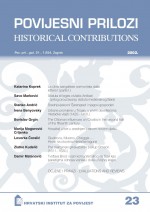Srednjovjekovni Šarengrad i njegovi gospodari
Medieval Šarengrad (Atya) and its lords
Author(s): Stanko AndrićSubject(s): History
Published by: Hrvatski institut za povijest
Summary/Abstract: Šarengrad, whose medieval name was Atya (a Hungarian word meaning ‘father’), is first mentioned in 1275 as an estate owned by Eynardus, son of a French-born royal officer Smaragdus. It was inherited by a stem of Eynardus’ descendants called de Kwke (today it would be ‘of Kukujevci’). In 1332-5, the parish church of St. Peter in Šarengrad, included in the jurisdiction of the archdeacon of Marchia in the bishopric of Pécs, paid a modest sum of 11 grossi for the extraordinary papal tithe. Because of disloyalty to the king Sigismund of Luxemburg, John of Kukujevci, called also “of Šarengrad”, lost his part of the Šarengrad estate, which the king handed over in 1398 to John of Morović [Hung. Marót], ban of Mačva († around 1434). Morović acquired the rest of the estate in 1404, again through a royal intervention, and in 1409, through an exchange of lands. In 1414, “the former castellans of Šarengrad” are mentioned; contrary to the common view, it seems that the castle was already built by the nobles of Kukujevci and not by ban Morović only. Morović built in Šarengrad a convent and a church of the Holy Spirit for the Franciscans of the Bosnian vicariate, for which he received several papal permissions (in 1405, 1411 and 1420). The completion of that project was certainly delayed by the fact that, after a defeat in Bosnia in 1415, Morović spent four years in the Ottoman captivity. The convent began its life after 1420 and the pope Eugenius IV (1431-1447) was the first to grant indulgences to the attenders of its church. In the summer and autumn of 1456, some Italian fellow friars of the later canonized John Capistran - who died on 23 October 1456 in the Franciscan convent in nearby Ilok - were recovering from illnesses in the convent of ©arengrad. The early collections of Capistran’s posthumous miracles, written in Ilok until 1461, mention twelve miracle beneficiaries from Šarengrad, mostly children; among them, a son of the court master of Louis of Morović. From the beginning of the 15th century, ©arengrad is regularly described as market-town (oppidum), and we know of four students originating from it who studied in Cracow and Vienna. The last member of the influential family of Morovič and another ban of Mačva, Mathew († 1476), made in 1470 his wife Margaret Szilágyi - a cousin of king Matthias Corvinus - the owner of the ©arengrad estate. In 1481, the estate was transferred to her magnate cousins, brothers Geréb of Vingárt. In the summer of 1490, the convent in Šarengrad was damaged in the attack which the partisans of Maximilian of Habsburg made on the estates of the Geréb family, who was a supporter of king Wladislas II. Nevertheless, the convent subsequently played an even more prominent role, the chapters of the Hungarian observant vicariate being held in it in 1495, 1499 and 1511.
Journal: Povijesni prilozi
- Issue Year: 2002
- Issue No: 23
- Page Range: 43-69
- Page Count: 27
- Language: Croatian

